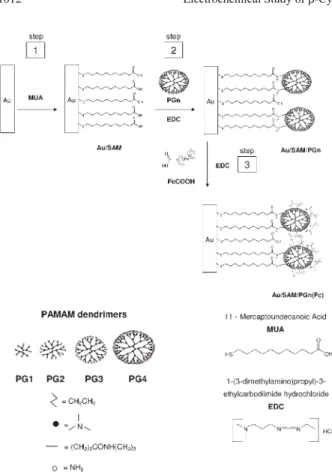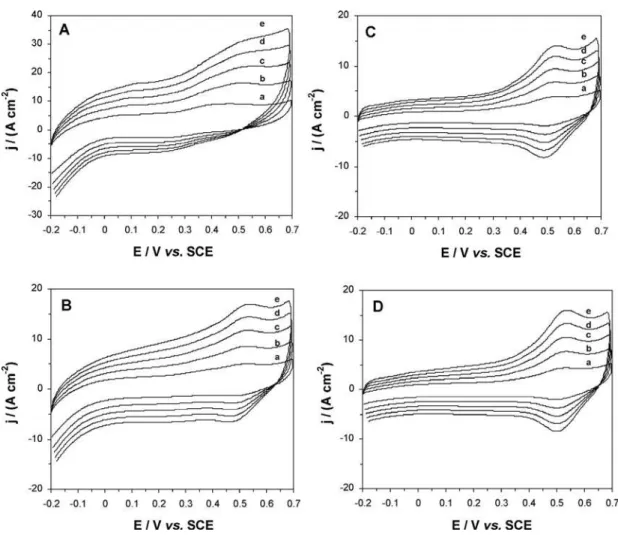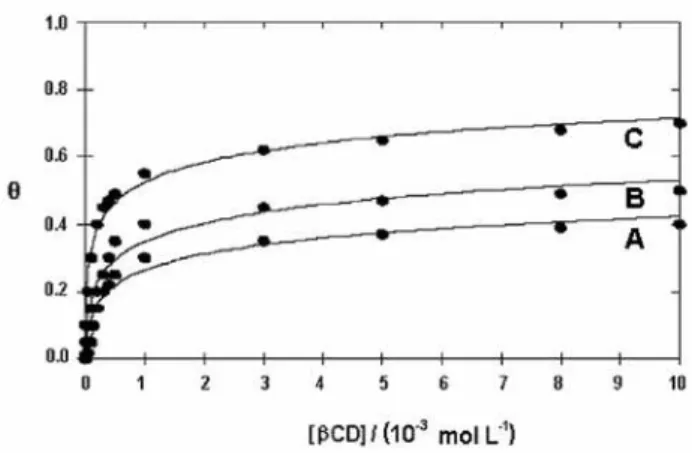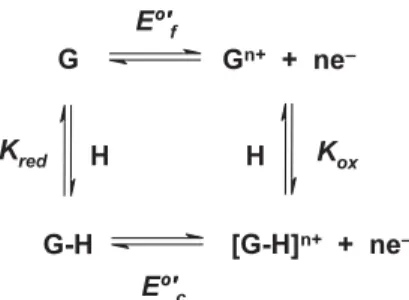Article
*e-mail: lgodinez@cideteq.mx
Electrochemical Study of -Cyclodextrin Binding with Ferrocene Tethered onto a
Gold Surface
via
PAMAM Dendrimers
E. Bustos,
aJ. Manríquez,
aE. Juaristi,
bThomas W. Chapman
aand Luis A. Godínez*
,aaElectrochemistry Department, Centro de Investigación y Desarrollo Tecnológico en Electroquímica,
Parque Tecnológico Querétaro, Sanfandila, Pedro Escobedo, 76703, PO Box 064, Querétaro, Mexico
bChemistry Department, Centro de Investigación y de Estudios Avanzados del I.P.N.,
PO Box 14-740, 07000 Mexico, DF, Mexico
Este artigo descreve a fixação de ferrocenos (Fc) sobre eletrodos policristalinos de ouro, por filmes dendrímeros de poliamidoamina (PAMAM). A superfície eletroativa fornece uma rota viável para investigar quantitativamente a ligação do ferroceno com a ciclodextrina (CD). Em particular, as medidas eletroquímicas, revelam o efeito das interações adsorção-adsorção sobre a constante de associação K, na interface eletrodo-eletrólito, durante a formação do complexo de 1:1 Os resultados obtidos a partir da investigação da isoterma de adsorção de Frumkin indicam que as interações podem ter um forte impacto na afinidade do CD com as superfícies do ferrocenil modificado, estudadas aqui. A técnica apresentada pode ser útil para investigar outras reações de ligação entre hóspede-hospedeiro.
This paper describes the tethering of ferrocene (Fc) onto polycrystalline gold electrodes by immobilized polyamidoamine (PAMAM) dendrimers films. The resulting electroactive surface provides a viable route for investigating quantitatively the host-guest binding of ferrocene with cyclodextrin (CD). In particular, electrochemical measurements reveal the effect of adsorbate-adsorbate interactions on the association constant K for the formation of the 1:1 CD Fc complex at the electrode-electrolyte interface. The results obtained from fitting the Frumkin isotherm to the adsorption data indicate that adsorbate-adsorbate interactions can have a strong impact on the CD affinity for the ferrocenyl-modified surfaces studied here. The technique presented may be useful for investigating other host-guest binding reactions.
Keywords: dendrimers, -cyclodextrin, ferrocene, inclusion complexes
Introduction
Supramolecular chemistry studies non-covalent interactions, such as electrostatic forces, hydrogen binding, solvophobic effects and cation- interactions, to understand the structure-activity relationships among a wide variety of molecules. In this context, supramolecular-chemistry researchers often investigate with electrochemical studies the formation of inclusion complexes by following the changes in the redox-activity behavior of an electroactive guest that is bonded non-covalently with a non-electroactive host.1-3
Many inclusion complexes involve a basket-like host, which acts as a receptor of a guest inside its cavity and sequesters the guest, inhibiting the electroactivity of the latter.
Ferrocene or bis(cyclopentadienyl)iron(II) (Fc) is probably the most common electroactive guest studied in supramolecular electrochemistry due to its synthetic accessibility and its convenient electrochemical properties.1
The most common hosts in Fc studies are the Schandinger’s dextrins or cyclodextrins (CD). Since these latter molecules have a basket-like structure, their cavities offer a partially hydrophobic environment that promotes the formation of inclusion complexes with those molecules having the proper size and affinity. For instance, it has been reported extensively that ferrocene can be readily inserted inside the cavity of the water-soluble -cyclodextrin ( CD).2,3 The predominant
driving force that promotes the formation of the 1:1 host-guest complex CD Fc is the so-called hydrophobic effect.4
specific solubility and reactivity properties.5,6 The
covalent incorporation of redox-active groups into dendrimers is an important area of chemical research, particularly employing these macromolecules as scaffolds for controlling the number and position of multiple functional groups on their periphery. Thus, such materials can be used as construction blocks to produce modified electrode surfaces having molecular-recognition properties for sensing enzymes,7,8 genetic
materials,9,10 antibodies,11,12 and other molecules showing
biological importance.13
Studies into the nature of the bonds involved in the supramolecular interactions between a non-electroactive host (e.g. CD) and an electroactive guest (e.g. Fc), have been conducted typically in aqueous media by monitoring the activity of the free guest molecule with an electrochemical probe. For example, the bonding of Fc to CD can be followed by assuming that electron-transfer does not take place from the inclusion complex. Voltammetric measurements are then interpreted in terms of a CE mechanism in which the complex must dissociate prior to electrochemical oxidation:14
CD Fc CD + Fc (1)
Fc Fc+ + e- (2)
On this basis, Kaifer and co-workers have demonstrated that the association constant K for the 1:1 inclusion complex CD Fc established in solution between dendrons bearing a single ferrocene group and CD hosts is strongly dependent of the size of the dendron.14 Specifically, the
largest monoferrocene-bearing dendron studied showed the smallest value for K (50 L mol-1), whereas the smallest
dendron exhibited the highest value for this parameter (950 L mol-1). According to the authors, this phenomenon
was explained satisfactorily by assuming that additional peripheral groups surrounding the ferrocenyl unit attached to these dendrons produce a steric hindrance that shifts the equilibrium of Reaction 1 to the right.
In this paper we present covalent modification of polycrystalline gold electrodes with attached ferrocene via linkages through PAMAM dendrimers of various sizes. With such electrodes modified with immobilized Fc we have conducted electrochemical studies that allow to investigate the magnitude of the binding forces related to the interfacial formation of 1:1 inclusion complexes CD Fc by attachment of CD from solution. This approach offers an alternative procedure to homogeneous-solution studies that can also reveal interesting properties of such electrodes.
Experimental
Reagents and Instrumentation
Commercially available PAMAMTM dendrimers of
generations 1.0 (PG1), 2.0 (PG2), 3.0 (PG3) and 4.0 (PG4) (bearing 8, 16, 32 and 64 terminal -NH2groups, respectively) and -cyclodextrin hydrate ( CD) of the best commercial quality were used. Similarly, reagent-grade 11-mercaptoundecanoic acid (MUA; HS(CH2)10COOH, 95%), 1-(3-dimethylamino)propyl-3-ethylcarbodiimide hydrochloride (EDC; 98%), and ferrocene monocarboxylic acid (FcCOOH; 97%) were obtained from Aldrich. Ru(NH3)6Cl3 (99%) was provided by Strem Chemicals. Analytical-grade NaF, KH2PO4 and Na2HPO4were obtained from J.T. Baker and used for preparing aqueous electrolytic solutions with deionized water ( 18×10-6 cm). All
chemical reagents were used without further purification. Electrochemical experiments were performed at 298 K with a BAS EpsilonTM potentiostat. Cyclic voltammetry
(CV) was carried out in a 10 mL BAS cell equipped with a platinum wire and a saturated calomel electrode (SCE) as counter and reference electrodes, respectively. Spherical polycrystalline-gold working electrodes were prepared by melting the tip of a gold wire (99.999%, PremionTM Alfa;
1.0 mm diameter) as was previously reported,16 resulting
in beads having a roughness factor of about 1.1.17 All
experiments were performed under an inert atmosphere by bubbling ultra-pure nitrogen (Praxair, grade 4.8) for at least 10 min. Computer fitting of CV data was carried out by means of the software MINSQTM (Least Squares Parameter
Estimation version 3.12 from MicroMath Inc.) installed in a PC based on a PentiumTM processor.
The true electroactive area of the gold electrodes A (0.02 0.005 cm2) was estimated by fitting the
Randles-Ševþik equation to plots of experimental cathodic peak current vs. potential scan rate, constructed with data from the reversible voltammetric responses for the fresh gold electrodes immersed in a neutral aqueous phosphate buffer (ionic strength, I= 0.1) containing the redox couple Ru(NH3)63+|Ru(NH
3)62+(0.5×10-3 mol L-1 Ru(NH3)6Cl3).18
Voltammograms of the Fc-modified electrodes were taken in 0.1 mol L-1 KF at 298 K.
Surface functionalization
in 1×10-3 mol L-1 MUA methanolic solutions at 298 K for
24h.19 The presence of the thiols on the metallic substrates
was confirmed by their electrochemical desorption in aqueous 0.5 mol L-1 KOH, as revealed by cathodic CV peaks
close to –1.0 V vs. SCE (data not shown). This reduction peak arises from the reaction:18,20
Au/S(CH2)10COOH + e– Au + –S(CH
2)10COOH (3)
MUA surface coverage MUA was calculated to be
9.05 10-11 mol cm-2 by means of Faraday’s law
MUA=QMUA(FA)-1 (4)
where the faradic charge (QMUA) associated with the desorptive process (equation 4) was estimated by integration of the relevant cathodic peak. If it is assumed that a closely packed monolayer of MUA should have a coverage ( MUA,m) of 1.2 10-10 mol cm-2,21 the current
procedure was sucessful in forming nearly a complete monolayer of MUA on the gold surface according to the ratio MUA/ MUA,m equal to 0.75.22
During Step 2 (Figure 1), PAMAM dendrimers were linked chemically to the functionalized gold electrodes by promoting the creation of amide bonds NH(CO) between
the COOH ends of the MUA and amine groups (NH2)
on the dendrimers. This was achieved by immersing the thiolated gold substrates in methanolic solutions containing 5×10-3mol L-1 EDC (to promote the creation of the
amide bonds) and 21×10-6 mol L-1 PAMAM dendrimer of
Generation 1.0 (PG1), 2.0 (PG2), 3.0(PG3) or 4.0 (PG4) for 12 h at 298 K.23 Subsequently, the dendrimer-functionalized
gold surfaces were washed by dipping them in gently stirred MeOH at room temperature. In Step 3 (Figure 1) the dendrimer-bearing substrates were then immersed in neutral aqueous phosphate buffer containing 1×10-3mol L-1
FcCOOH with 5×10-3mol L-1 EDC for 24 h at 298 K in
order to tether the ferrocenyl moieties to the dendritic adsorbates through another set of amide bonds.24,16 The
resulting electrode surfaces were washed by dipping them in gently stirred clean buffer solutions.
Results and Discussion
Tethering of ferrocene onto the gold electrodes
The attachment of the Fc moieties onto the gold substrates was revealed by the voltammograms shown in Figure 2, in which characteristic peaks appear around 0.5 V vs. SCE for the four electrodes: (A) Au/SAM/PG1-Fc, (B) Au/SAM/PG2-Fc, (C) Au/SAM/PG3-Fc, and
(D) Au/SAM/PG4-Fc in 0.1 mol L-1 KF at 298 K.
Table 1 gives the estimates of the redox potentials obtained from the peaks in Figure 2, which correspond to the redox reaction:
Au/SAM/PGn-Fc Au/SAM/PGn-Fc+ + e– (5)
Inspection of Figures 2A-2D and Table 1 suggests that the electron transfer (ET) rate between the Fc moieties and the electrode substrate is strongly dependent on the
Figure 1. Schematic outline of the process used to prepare the gold electrodes compared in this study: (Step 1) Thiol modification of the gold surfaces to form Au/SAM; (Step 2) Dendrimer functionalization of the thiolated gold surfaces to produce Au/SAM/PGn, where n=1, 2, 3, 4; and (Step 3) Tethering of ferrocenyl moieties onto the immobilized dendrimers generating Au/SAM/PGn-Fc.
Table 1. Electrochemical parameters obtained from the CV responses in 0.1 mol L-1 KF at 298 K for the four ferrocene-dendrimer-modified
electrodes studied
System aE0
f/ V vs. SCE Fc/ 10
-10 mol cm-2
Au/SAM/PG1-Fc b 0.5
Au/SAM/PG2-Fc 0.50 2.0
Au/SAM/PG3-Fc 0.50 6.0
Au/SAM/PG4-Fc 0.51 6.5
aestimated by the relationship E0
f= 1/2(Epa,f – Ecp, f) for the free form
dendrimer generation n. For instance, the CV responses observed at different potential scan rates (dE/dt) appears to be quasi-reversible and highly capacitive for the Au/SAM/ PG1-Fc electrode (Figure 2A), whereas the responses for the three other surfaces, Au/SAM/PG2-Fc, Au/SAM/PG3-Fc and Au/SAM/PG4-Au/SAM/PG3-Fc (Figures 2B-2D, respectively), could be considered to be reversible and less capacitive. Indeed, it is not possible to identify clearly the peak potentials for the Generation-1 electrode because the peaks are obscured by the capacitative behavior. The reversible behavior observed with the three larger dendrimers and the trends seen in Table 1 may indicate that the attachment of larger dendrimers to the gold surface affects the structure of the interface to reduce the double-layer capacitance. Also, it is noted that the charge transfer (ET) between the Fc and the gold substrate, which occurs by electron-tunneling as reported by Kwak and co-workers,9,12 is actually facilitated
by the larger dendrimers, at least up to Generation 4. The molar surface coverage of the tethered ferrocenyl groups to the modified gold electrodes Fc was estimated by integrating the charge under the anodic peaks in their
CV responses at 0.1 V s-1 (see Figure 2) and applying
Faraday’s law for a one-electron transfer. The results are given in Table 1. The estimated loadings were 2.0, 6.0 and 6.5 10-10 mol cm-2 for Generations 2, 3 and 4, respectively.
Considering 4.5 10-10 mol cm-2 as the typical value for a
closely packed monolayer of directly adsorbed Fc units on a smooth surface,25,15 the experimental coverages for the Fc
moieties in the tested systems were of similar magnitude and actually exceeded the planar monolayer value by 33% and 44% for the two largest dendrimers. This result shows that the kinetically fastest CV responses (see Figure 2) are obtained with the greatest loading of ferrocene and that the dendrimer tethering actually enhances the voltammetric response of adsorbed Fc.
Binding of CD with Fc tethered to the dendrimer films
The strength of the interactions that promote the formation of 1:1 Fc CD complexes between the CD hosts and the immobilized ferrocenyl guests on the dendrimer-modified electrodes films was investigated by
Figure 2. CV responses in aqueous 0.1 mol L-1 KF at 298 K of the four types of electrode: (A) Au/SAM/PG1-Fc, (B) Au/SAM/PG2-Fc, (C) Au/SAM/
observing the adsorption of CD from aqueous solution as a function of CD concentration. Known amounts of CD were added to the 0.1 mol L-1 KF solution, and the
resulting change in the Fc CV response was observed, as shown in Figure 3. These data were interpreted in terms of the following two reactions:
Au/SAM/PGn-Fc CD CD + Au/SAM/PGn-Fc(6)
Au/SAM/PGn-Fc Au/SAM/PGn-Fc+ + e- (7)
It was assumed that the ferrocene bound to cyclodextrin is not electroactive. Thus, the fractional coverage of Fc by
CD, , may be estimated from the relation
(8)
where Q and Q0 represent the charges associated
with the CV oxidation of Fc with and without CD, respectively, calculated from the curves shown in Figure 3. The experimental results for as a function of CD concentration are shown in Figure 4 as adsorption isotherms for the electrodes produced with dendrimers of Generations 2, 3, and 4.
In order to understand better the binding process, the adsorption data in Figure 4 were fitted with the so-called Frumkin isotherm.18,26 Due to the combination of its
simplicity and the relevant thermodynamic information that it provides, this model is by far the most popular isotherm which, also, has been successfully used for dendrimer modified electrode studies:27,28
(9)
whereC is the molar concentration of CD in solution, and K stands for the apparent association constant related to the formation of the Fc CD complexes (equal to the reciprocal of the equilibrium constant for equation 6), which may be related to the free energy of the CD adsorption in the limit of very low surface coverage by CD, Gt=0ads, according to the relation
(10)
Equation 9 is derived taking into account lateral interactions between the adsorbed molecules. Thus, the parameter a reflects the strength of the intermolecular interactions between CD adsorbates, which may be considered dependant on the dendritic size, because of the changing surface geometry. Assuming that the ferrocenyl guests immobilized on the smallest size dendrimers might be confined more closely than those borne on the larger dendrimers, it could be expected that the largest adsorbate-adsorbate repulsive interactions should be observed for the former situation and decrease gradually as an inverse function of the dendritic generation.29-33
Table 2 gives the values of K, Gt=0ads, and a that were obtained by fitting the Frumkin-isotherm curves to the data in Figure 4. As it can be seen from the fitted values, the association constant K for adsorption onto the immobilized Fc varied inversely with the dendritic size, and Gt=0ads became more negative. Thus, the CD adsorption becomes thermodynamically more spontaneous when dendrimer size increases. Consistent with these observations, the interaction parametera decreased with dendrimer size as well.
Although Table 2 reveals that the magnitudes of the parametersK and Gt=0ads for CD binding to the tethered
Figure 3. CV responses at dE/dt= 0.5 V s-1 in 0.1 mol L-1 KF at 298 K
at various concentrations of CD for the modified electrodes Au/SAM/ PG4-Fc after the introduction of (a) 0, (b) 0.001, (c) 0.1, (d) 0.5, and (e) 1 ×10-3mol L-1 CD. A similar trend was observed for the curves obtained
for the systems Au/SAM/PG2-Fc and Au/SAM/PG3-Fc.
Figure 4. Adsorption isotherms of CD from 0.1 mol L-1 KF at 298 K
ferrocene are small and comparable to some values previously reported for similar species in aqueous media,34
the Fc CD binding was expected to be larger (on the order of 103 L mol-1) on the basis of other measurements of this
interaction in aqueous medium.14 A possible explanation
for our observations considers that the inclusion of ferrocene units inside the cyclodextrin cavity is mainly controlled by a positive entropic change ( Sº) for the water molecules which,1,35 upon inclusion, are transferred from
the hydrophobic basket-like cavity (S0
H2O, cavity) of CD to the solution bulk (S0
H2O, bulk).
Sº = S0
H2O, bulk – S 0
H2O, cavity (11)
A similar entropy balance can be considered for the inclusion reaction carried out on the electrode-solution interface where S0
H2O, interfacerepresents the entropy of water molecules located in this region.
Sº = S0
H2O, interface– S 0
H2O, cavity (12)
Comparison of equations 11 and 12 allows to predict that the stability constants K for the interfacial Fc CD complexes (see Table 2) must be lower36 than those
observed in solution,14 if S0
H2O, interface < S 0
H2O, bulk. This condition holds when we note that the dielectric constants, H2O, for interfacial and bulk water regions (related to water structure rigidity or entropy), are 6 and 80 respectively.37 In this
way, if H2Oincreases as a function of the distance from the electrode surface, then the ferrocenyl groups located on the dendrimers having the largest size (or Generation) will not only show the largest values for K, but also the smallest repulsive interactions a>0 between the adsorbates (as it can be observed in Table 2).
The relatively low values of K presented in Table 2 can also be related to the small potential difference, E0, between the formal redox potentials of the free E0
f and the complexed E0
c forms of ferrocene that was previously observed in Figure 3. As can be seen from the equilibrium reactions shown in Scheme 1, equation 13 can be used to relate E0 as a function of Kred and Kox,which represent the stability
constants of the supramolecular complexes of the reduced and the oxidized forms of ferrocene, respectively.38
(13)
If Kred (the stability constant K in equation 9) and Kox (which has been reported to be small since the CD inclusion process for the oxidized ferrocene form is not a thermodynamically favored process)38 are small, then the
Kred/Kox ratio tends to be one resulting in a E0ca. ,i.e., close values of E0
fandE 0 c.
Conclusions
We have described the preparation of ferrocenyl tethered to PAMAM-dendrimer films on polycrystalline gold electrodes as a viable way for studying electrochemically the formation of the 1:1 Fc CD complex at an electrode-electrolyte interface. In particular, this approach allows one to examine the effects of dendritic Generation on the binding and the lateral interactions between the adsorbates. The results obtained from the adsorption data revealed that the adsorbate-adsorbate interactions represent another variable that should be considered in describing the formation of the Fc CD complexes in the electrode-electrolyte interfaces. This experimental approach may be useful for examining other guest-host molecular processes.
Acknowlegments
The authors are grateful to Consejo Nacional de Ciencia y Tecnología (CONACyT, grant 45157) for the financial support of this work. EB is also grateful to CONACyT for a doctoral scholarship. TWC is a CONACyT Cooperante in CIDETEQ under the sponsorship of the U.S. Peace Corps.
References
1. Kaifer, A. E.; Gómez-Kaifer, M.; Supramolecular
Electrochemistry, Wiley-VCH: Weinheim, 1999.
Scheme 1. Coupled electrochemical and chemical equilibria for an electroactive guest, G, (Fc), with a non-electroactive host, H, ( CD). Table 2. Binding parameters for the association of the CD host with the
immobilized dendrimer-tethered Fc at 298 K in aqueous 0.1 mol L-1 KF
System K / (L mol-1) a Gt=0
ads/ (kJ mol-1)
Au/SAM/PG2-Fc CD 5.0 0.5 10.02 1.06 -13.94
Au/SAM/PG3-Fc CD 10.4 1.4 8.55 1.10 -15.76
2. Saenger, W.; Angew. Chem. Int. Ed. Engl. 1980,19, 344.
3. Bersier, P. M.; Bersier, J.; Klingert, B.; Electroanalysis 1991,
3, 443.
4. Reetz, M. T.; J. Heterocyclic Chem.1998,35, 1065.
5. Frêchet, J. M.; Science1994,263, 1710.
6. Crooks, R. M.; Lemon III, B. I.; Sun, L.; Yeung, L. K.; Zhao, M.;Dendrimers: Design, Dimension and Function; Springer-Verlag; U.S.A; 2001.
7. Yoon, H. C.; Hong, M.-Y.; Kim, H.-S.; Anal. Chem.2000,72,
4420.
8. Yoon, H. C.; Hong, M.-Y.; Kim, H.-S.; Anal. Biochem.2000,
282, 121.
9. Kim, E.; Kim, K.; Yang, H.; Kim, Y. T.; Kwak, J.; Anal. Chem.
2003,75, 5665.
10. Sato, S.; Nojima, T.; Kaki, M.; Takenaka, S.; Molecules2005,
10, 693.
11. Yoon, H. C.; Lee, D.; Kim, H.-S.; Anal. Chim. Acta2002,456,
209.
12. Kwon, S. J.; Kim, E.; Yang, H.; Kwak, J.; Analyst2006,131,
402.
13. Astruc, D.; Daniel, M.-C.; Ruiz, J.; Chem. Commun.2004,
2637.
14. Cardona, C. M.; McCarley, T. D.; Kaifer, A. E.; J. Org. Chem.
2000,65, 1857.
15. Sabapathy, R. C.; Bhattacharyya, S.; Clealand, Jr., W. E.;
Hussey, C. L.; Langmuir1998,14, 3797.
16. Godínez, L. A.; Castro, R.; Kaifer, A.E.; Langmuir1996,12,
5087.
17. Trasatti, S.; Petrii, O. A.; Pure Appl. Chem.1991,5, 711.
18. Manríquez, J.; Juaristi, E.; Muñoz-Muñiz, O.; Godínez, L. A.; Langmuir2003,19, 7315.
19. Summer, J. J.; Creager, S. E.; J. Phys. Chem. B 2001,105,
8739.
20. Lee, L. Y. S. ; Lennox, B.; Langmuir2007,23, 292.
21. Ulman, A.; Chem. Rev.1996,96, 1533.
22. Arias, F.; Godínez, L. A.; Wilson, S. P.; Kaifer, A.; Echegoyen, L.;J. Am. Chem. Soc.1996,18,6086.
23. Collinson, M.; Bowden, E. F.; Tarlov, M. J.; Langmuir1992,
5, 1247.
24. Nijhuis, C. A.; Sinha, J. K.; Wittstock, G.; Huskens, J.; Ravoo,
B. J.; Reinhoudt, D.N.; Langmuir2006,22, 9770.
25. Sabapathy, R. C.; Bhattacharryya, S.; Cleland Jr., W. E.; Hussey,
C. L.; Langmuir1998,14, 3797.
26. Frumkin, A. N.; Damaskin, B. B. In Modern Aspects of
Electrochemistry No. 3; Bockris, J. O’M., Conway, B. E., eds.; Butterworths: London, 1964.
27. Takada, K.; Díaz, D. J.; Abruña, H. D.; Cuadrado, I.; Casado,
C.; Alonso, B.; Morán, M.; Losada, J.; J. Am. Chem. Soc.1997,
119, 10763.
28. Takada, K.; Díaz, D. J.; Abruña, H. D.; Cuadrado, I.; González,
B.; Casado, C. M.; Alonso, B.; Morán, M.; Losada, J.; Chem.
Eur. J.2001,7, 1109.
29. Tang, L.; Zhu, Y.; Xu, L.; Yang, X.; Li, C.; Electroanalysis2007,
19, 1677.
30. Crespilho, F. N.; Ghica, M. E.; Zucolotto, V.; Nart, F. C.; Oliveira
Jr., O. N.; Brett, M. A. C.; Electroanalysis2007,19, 805.
31. Zhang, Y.; Zhao, C.; Yang, J.; Kapiamba, M.; Haze, O.;
Rothberg, L. J.; Ng, M.-K.; J. Org. Chem.2006,71, 9475.
32. Kim, D. H.; Lee, O.-J.; Barriau, E.; Li, X.; Caminade, A.-M.;
Majoral, J.-P.; Frey, H.; Knoll, W.; J. Nanosci. Nanotechnol.
2006,6, 3871.
33. He, P.; Li, M.; Hu, N.; Biopolymers2005,79, 310.
34. Rekharsky, M. V.; Inoue, Y.; Chem. Rev.1998,98, 1875.
35. Inoue, Y.; Hakushi, T.; Tong, L.-H.; Shen, B.-J.; Jin, D.-S.; J. Am. Chem. Soc.1993,115, 475.
36. Jong, M. R.; Huskens, J.; Reinhoudt, D. N.; Chem. Eur. J.2001,
7, 4164.
37. Bockris, J. O’M.; Reddy, A. K. N.; Gamboa-Aldeco, M.; Modern Electrochemistry 2A: Fundamentals of Electrodics,
2nd ed.; Kluwer Academic: New York, 2000.
38. Mendoza, S.; Castaño, E.; Meas, Y.; Godínez, L.A.; Kaifer,
A.E.;Electroanalysis2004,16, 1469.
Received: October 31, 2007



